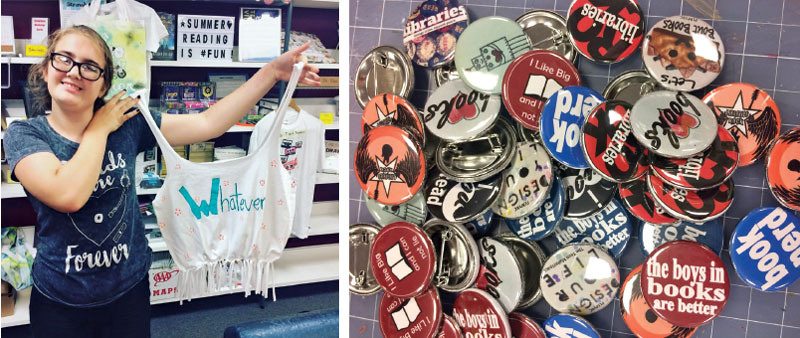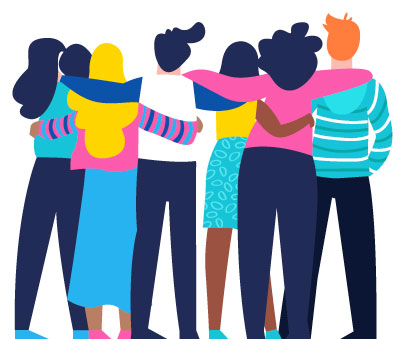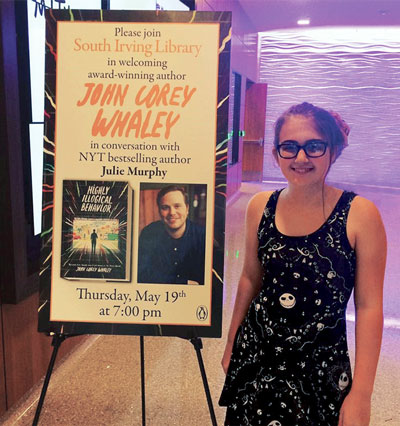Planning Ahead: 9 Ways To Drive Teen Turnout at Your Library—and 4 Ways To Lose their Attention
Things to bear in mind when your library re-opens for programming: Opportunities for self-expression, games, and makerspaces are a draw. Anything school-like is not.
 |
Teenagers are drawn to activities that involve self-expression, from designing T-shirts with slogans to button making. |
What do teens want from library programming? What do they show up for, and what drives them away?
Professional literature about library programming and teens tends to focus on certain concepts, using language such as “outcomes-based,” “educational goals,” “curriculum support,” and “ROI” (return on investment). This is how we sell the idea of programming and programming support to administrators, parents, and the community at large. While all of this has value—because we need support, staff, and budgets to get things done—I want to focus on value-driven teen programming itself.
However, instead of talking about the value that successful teen programming brings to our libraries (more visitors, stronger community support, better PR) and communities (engaged teens are less likely to engage in risky behavior), it’s time to talk about the value of programming for our teens. What they need, want, and value, I would argue, is the best starting point for developing meaningful, effective initiatives.
Here’s my list of what drives turnout and what doesn’t, based on what I’ve learned in more than 25 years of developing teen programming, conversations on social media, and informal polls with 50 teen librarians. I vetted this best-practices list with 10 respected librarians who serve teens. We all agree that while there are no hard-and-fast rules, we know how to identify promising starting points for programming that teens love—or at least will show up for.
What works
1. Opportunities for self-expression
“Who am I?” Adolescents ask themselves this question repeatedly, so give them ways to figure it out. An engaging, meaningful teen program enables teens to explore and express themselves
creatively. There’s a reason I know 22 different ways to make a T-shirt!
Teens like to create things that reflect who they are and how they feel. There’s plenty of content options to consider: Creative writing, journaling, digital media, meme creation, and craft programs, for instance, all give teens the practical tools and emotional space to be themselves.
2. Pop culture tie-ins
Some of my most popular programs have been Harry Potter, Doctor Who, and Sherlock-related. The trick is to pay attention to what your teens are into and strike while the iron is hot—even if it’s a quick, last-minute program. “Teen Librarian Toolbox” contributor Cindy Shutts has gone so far as to create escape rooms that tie in to popular TV shows and pop culture touchstones, including Riverdale and Star Wars. It’s doubly effective when you’re pulling two trends together. Try to talk with your teens daily, to discover what they love, and build programming around that. This communicates respect and shows that you’re listening while inviting your teens to have fun with you in the library.
3. Escape rooms
As Shutts has proven, escape rooms are great for getting teens into the library and working together in teams to problem-solve while having fun. These activities are similar to interactive murder mysteries, which I’ve also successfully hosted. Solving puzzles or mysteries, following a trail of clues, and literally trying to escape a room is exciting and in-the-moment. It’s entertaining, and it also gets teens to try out real-life problem-solving strategies—a win for those of us doing programming. We can sell them as educational to our administrators—and sell them as fun to our teens.
4. Maker programs
You don’t have to have a dedicated makerspace to host a maker program. Many teen programs such as crafting and DIY activities have always been maker-related. They’re popular for a reason! These activities are valuable because they’re educational, they create an environment that encourages self-expression, and they allow teens to take an item home. Everyone, including teens, likes to leave with something they’ve created.

5. Gaming
Gaming—both tabletop and electronic—is always a big draw. Games aren’t necessarily quiet, so choose your space and time accordingly. An array of available research attests to the benefits of both types of gaming, and I urge you to look into it if you need to make a defense to administrators about why gaming should be a part of your teen programming. (The American Library Association’s Gaming Round Table provides a good starting point. One benefit of gaming is that it lets young people interact socially with their peers. At the end of the day, that’s all most teens want: a place to call their own and hang out with their friends.
6. Trivia events
These are often an easy sell—and more so if you loop in popular media. “Stump the librarian,” pop culture trivia nights, and classic multi-category trivia nights all make for engaging experiences. Trivia events can be their own programming or part of a wider themed event. For example, most Harry Potter programs have a trivia component. A night of food, trivia, and fun with friends will get a lot of kids coming through your doors.
7. Life-size games
I was turned on to life-size games when former teen librarian Heather Booth blogged for “Teen Librarian Toolbox” about life-size Angry Birds. I repeated that program multiple times while the Angry Birds game was popular. A quick Internet browse will yield ideas for life-size chess, Candy Land, Hungry Hungry Hippos, and more. These games often tap into childhood nostalgia and have the fun factor of making little things big, potentially taking an entertaining game night to a whole new level. Sometimes bigger really is better.
8. More on nostalgia
When one of my previous makerspace assistants suggested that we put a Perler bead station in the makerspace, I argued that it was too juvenile for teens. I was wrong. My teens—on the cusp of adulthood—often tell me that they like things that are childlike or remind them of their childhood. Sometimes, they just want a chance to dive back into earlier, carefree moments. They also like to engage in decade-themed parties. Eighties nights, for instance, mean dressing up in ’80s gear, watching movies from the ’80s, and engaging in retro trivia. This may not be your patrons’ own experience, but it’s still popular.
9. Food
If you feed them, they will come. That’s a refrain librarians share about teen programming. I have mixed feelings about this. One in 12 people has a food allergy, some of them life-threatening, according to a 2018 study. So if a majority of our social activities are food-based, that can exclude people.
At the same time, I know that one in seven U.S. children lives with hunger, according to the organization Feeding America, so having things to eat at an event can help them. More to the point, food-based programming works. My Cupcake Wars–style events are always well attended. So I recommend being mindful of food allergies. Know what the top eight food allergens are and provide options. Run advertising that specifies which foods will be present, and keep all packaging so participants can refer to ingredient listings.
Because nut allergies are so prevalent, and often deadly, stay away from nuts altogether. Also, be aware of food handling laws in your immediate area before introducing this programming at your library. With all those caveats in mind, offering something to eat usually boosts success.
 |
Karen Jensen’s daughter attends an author event at the Irving (TX) Public Library. |
What falls short
1.Book clubs
Book clubs are tricky, as kids are already discussing books in English class and don’t want to repeat the exercise in their free time. Public librarians who do pull kids in tend to organize targeted book clubs on themes ranging from mental health to mysteries. A more creative approach to reading-based initiatives is to intertwine books with making. Book covers and favorite quotes can be the start of an amazing T-shirt or meme. You can use technology to teach teens how to make their own book trailers.
2. Lectures
n the whole, teens seem the least intrigued by information sessions or lecture-type programs, though Booth has hosted some well-attended career panels. The Irving (TX) Public Library hosts author panel discussions that have well over 100 teens in attendance. In 25 years, my least-attended programs have been education-based. If you’re eager to host these, coordinate with local agencies and schools, which may offer extra credit to students for attending.
3. No personal choice
It seems that the more teens can choose their own path, the more successful a program will be. We know where teens are developmentally and what the rest of their day probably looks like. During the school year, our kids have just spent eight hours in a highly structured environment where adults have dictated almost every moment of their day. The last thing they want to do in their free time is to come to another highly structured environment where another adult is going to tell them what to do.
So let’s give them choices instead. For example, if you’re going to host a craft program, consider offering five activities instead of one, which lets the participants choose what they do within that time and space. It’s more appealing to choose from multiple stations than to do one activity directed by an adult. So whenever you can, and in whatever way you can, open up your programming to allow for greater choice.
4. Anything school-like
It can’t be anything like school. That’s the number one statement I got from fellow teen/YA librarians about teen programming. By the time our teens come through our doors, they’re done with anything resembling school. I’m not saying that programming can’t be educational. It should help teens achieve educational goals in fun ways. Keep in mind that teens deserve recreational opportunities and downtime as much as anyone else. There’s tremendous value in providing our teens with that.
Over the years, I’ve changed my approach to teen programming. While I haven’t completely abandoned the educational goals, I’ve come to understand that not all people learn in the same way. There’s value in pure fun, and what teens need from public libraries is very different than what they need from school. That shift in mind-set has helped me engage their curiosity—and be a better librarian.
Karen Jensen is the children’s and YA materials selector at the Fort Worth (TX) Public Library. She blogs at “Teen Librarian Toolbox.”
RELATED
The job outlook in 2030: Librarians will be in demand
The job outlook in 2030: Librarians will be in demand
ALREADY A SUBSCRIBER? LOG IN
We are currently offering this content for free. Sign up now to activate your personal profile, where you can save articles for future viewing





Add Comment :-
Be the first reader to comment.
Comment Policy:
Comment should not be empty !!!